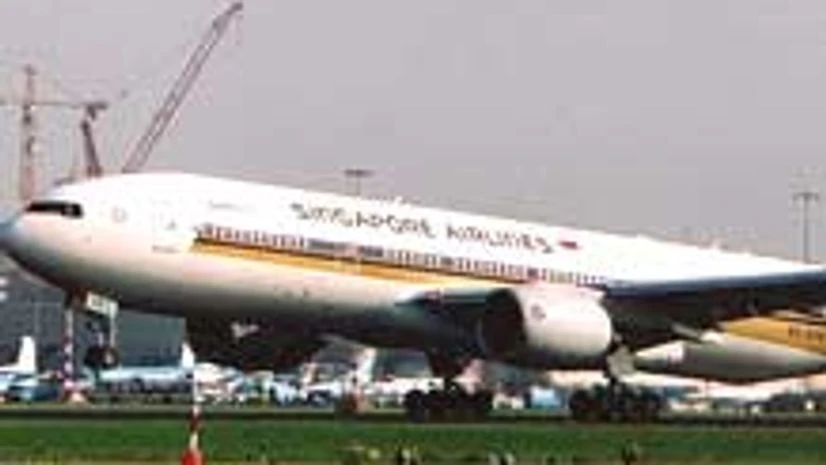Singapore Airlines' (SIA) partnership with the Tata Group to start a new domestic airline in India declares its designs on Asia-Pacific in a way that its previous alliances and investments have not.
Dependent on international passenger traffic, SIA is trying to reduce its exposure to markets in the US and Europe. Premium travel saw a decline on the back of a weakened Europe. The stronger market of the US is also being served by competition such as Hong Kong's Cathay Pacific with a strategic geographical advantage. Asia-Pacific then, holds the most promise for SIA.
With its $ 49 million investment (49 per cent of the JV) in the full-service airline, SIA will attempt to tap the premium market in the country, dominated by Jet Airways after the collapse of Kingfisher Airlines, and create a hub in New Delhi, to link the Americas with Australia, one of its stronger markets. It would have to do this amidst increasing competition from Gulf carriers and low cost carriers (LCCs). SIA chairman Stephen Lee had hinted at its intention in July when he had said the airline was looking for investment opportunities in India, and that along with China, it was a key market.
Also Read
| PIONEERING TRAITS |
|
On SIA's radar will be the premium market in the domestic skies, that has very few players right now, and strong imminent competition from the Jet-Etihad partnership. Shashank Nigam, CEO of SimpliFlying, a Singapore-based aviation brand strategy firm, says, "The SIA and Tata Group venture comes with deep pockets ($100 million for now), and certainly has the potential to make it big in the under-served premium end of the market. We'll see two major groups fighting for the high-yielding customers, as the likes of Air India have lost ground in that market, and Kingfisher has not flown for a year. While most aviation players lost money, the market is ripe for innovation in premium services."
SIA is not a stranger to innovation (see box) and has been able to hold on to its branding, according to experts. In keeping with its premium positioning, SIA has been steadfast in its focus on its recruits who service passengers and its planes which provide the comfort needed for a premium feel. It is known to train staff for four months rather than the average two months. It is also known to command a price premium and avoid reactionary fluctuations. It was the first to fly the super-jumbo Airbus A380 and will be one of the first to fly the extended version of Boeing 787, which promises to cover upto 90 per cent of all wide-bodied aircraft routes from 2018 onwards.
But SIA has been having a tough time of late. The International Air Transport Association says premium travel grew by 3.2 per cent in the first half of 2013, over last year, in contrast to the 4.8 per cent rate seen in 2012. SIA saw a modest increase in profits by 3.3 per cent to $187 million.
"SIA is facing pressure in its home market from new competition and is seeking new opportunities for future development. The growth potential of India, and particularly the rising middle class who travel the most, fits well with Singapore's reputation for quality service," says UK-based aviation consultant John Strickland.
The Centre for Asia Pacific Aviation in its recent report states how Cathay Pacific has the advantage of using
Hong Kong as a hub for traffic from the US (still a strong market for premium travel) because its northerly location makes it less prone to diversions through West Asia by the Gulf carriers than Changi airport.
SIA has had intense competition from Gulf carriers on Europe-Asia routes and LCCs on the South-east Asia, China and Australia routes. The parent group of SIA has diversified into two LCCs (the long-haul Scoot, wholly-owned and Tigerair, a partnership) to take on AirAsia, Jetstar and Lion Air.
But SIA is keen to reinforce its full-service credo, unveiling a new campaign called 'The Lengths We Go To', reminding premium business travellers of its service. After all, business class fares are four-eight times that of economy class tickets. Featuring its icon, the Singapore Girl (cabin crew), the TVCs trace her to tea gardens and tanneries, procuring ingredients for a tailored in-cabin experience of jasmine tea and plush leather first-class seats.
"Even as competitors begin to develop similar products, we have not lost our focus on delivering the famed Singapore Airlines hospitality and warm service," says vice president (public affairs) Nicholas Ionides. Nigam reminds, "SIA is not re-inventing the brand, but emphasising that they go the extra mile for passengers." However, Hong Kong-based analyst Daniel Tsang says SIA is playing catch-up to competition from West Asia and Asia with new three-class products (SIA unveiled the $150 million cabin upgrade in July) since its last revamp in 2007.
SIA had drawn flak for not picking partners to augment its network. But its flight frequencies have increased to Australia (by 45 per cent), China (by 71 per cent) and India (by 24 per cent) over 2010 by dint of recently-struck partnerships. The Tata JV should help further.

)
